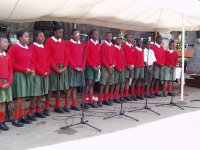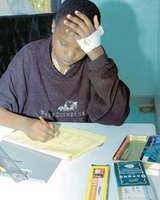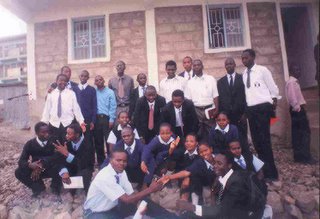[ . BACK to WORLDKIGO TOP . ]:::::::::::::::::::::::::::::::::::::::::::::::::::::::::::::::::::::::::::::::::::::::::::::::::::::
World AIDS Day
***** Location: Kenya and worldwide
***** Season: Hot dry season (Kenya), Winter
***** Category: Observances*****************************
Explanation
World AIDS Day takes place every year on 1 December.
From small and thoughtful beginnings, which I remember in Kenya over a decade ago, it has become a major event, not only in Africa, living so directly with AIDS, but also in the global North. The main purpose of World AIDS Day is to raise awareness and support, and increasingly to focus on specific issues around HIV and AIDS.
In order to express solidarity with AIDS patients, the red ribbon is worn by many supporters around the world. Here it is, taken from the
Daily Nation on 2 December 2005.

In 2005, the focus was on the "3 by 5" programme -- three million AIDS sufferers to be supplied with anti retroviral drugs (
ARVs) by the end of 2005.
In Kenya, World AIDS Day is taken very seriously by the government, and the newspapers devote significant column inches to it. There are many events attracting the general public, and the schools perform plays and sketches with AIDS as their subject. It is sadly amazing how great is the awareness of AIDS among young school children, who in another place and time would have been innocent about problems sexual.
Isabelle Prondzynski.
http://www.nationmedia.com/dailynation/nmgindex.aspxxxxxxxxxxxxxxxxxxxxxxxxxxxxx
Students at
Bahati Community Centre School in Kayole, Nairobi, present a skit on rape and AIDS
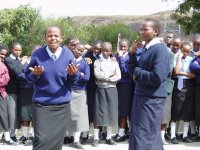
© Isabelle Prondzynski
One of the students from Bahati Community Centre writes :
My name is Alfrine Akoth Okuku. I was born in 1990. I did my K.C.P.E in 2004 and scored 268 out of 500. I joined Bahati Community Centre in 2005 and am in Form One North. We are five children in our family: four girls and one boy. Our parents died of HIV/AIDS and now we are orphans. My father died first then my mother followed. Currently, I am staying with my uncle in Soweto, but life is very hard for me; sometimes I have no place to sleep because we are too many in my uncle's house. Sometimes I go without food for a whole day.
When I look behind, there is no alternative because I don't have anybody to assist me pay school fees; I went to all my relatives but nobody agreed to take me to school. As for now, I do not know what to do because I do not have books to write in; when it reaches time for writing notes, I usually borrow from my friends. I only have one dress which I change everyday.
I would like to become a nurse so I can help the orphans, less fortunate and the neglected. I like assisting my friends whenever they are in need of learning. My hobbies are reading storybooks, making friends and cracking jokes.
http://bahatia.blogspot.com/xxxxxxxxxxxxxxxxxxxxxxxxxxxxx
War on Aids losing steam
Publication Date: 1 December 2005Today, Kenyans and the rest of the world mark the World Aids Day. Unfortunately, only a small number of those infected, and a rapidly growing number of those directly affected, will see any significance in the ceremonies arranged to mark the day.
If it is true that Kenya has shown signs of a decline in HIV prevalence over the past few years, with adult infection rates decreasing from 10 per cent in the 1990s to seven per cent today, this should not be any reason for complacency.
And if it is true, as the National Aids Control Council (Nacc) says, that Kenya has managed to put 50,000 people under anti-retroviral treatment, which prolongs life and generally improves the health of the sufferers, this, too, should not lull us to sleep.
For this must be just a fraction of those infected and those needing medical assistance to cope. Most likely, three times as many die of Aids complications every year, and are quietly buried.
Going by the most recent statistics, more than 1.5 million Kenyans are living with Aids - out of 40.3 million worldwide - a huge number of them Aids orphans. What, then, is there to celebrate about?
If, as has been claimed, about 80,000 Kenyans were last year alone newly infected by HIV, it means that at least 7,000 Kenyans are "catching it" every month, leading to the conclusion that the message is still not quite sinking in.
Although HIV/Aids was declared a national disaster in Kenya before 2002, the campaign to drive the prevention message home has not been as vigorous as would have been expected.
Most of our leaders seem to have more important things to think about than preventing the death of thousands of young Kenyans every month. There should never be room for complacency on this most vexed of epidemics. Right now, the world's attention is riveted on bird flu, a disease that has killed only 68 people worldwide.
The danger is that Aids might be forgotten in the Western fascination with the novelty, which means that a few million more will be consigned to an early grave due to ignorance and neglect if we relent in the fight.
http://www.nationmedia.com/dailynation/nmgcontententry.asp?category_id=24&newsid=62511
xxxxxxxxxxxxxxxxxxxxxxxxxxxxx
In Kenya, 29 Anglican dioceses held a national week of prayers for people living with AIDS. Anglican Church of Kenya Provincial Secretary Bishop William Waqo said that in the past, the church had "joined the bandwagon of condemning people infected by AIDS," but now there is growing awareness of the need to preach hope amidst the pain and despair of the disease.
http://www.anglicanjournal.com/130/01/world01.htmlxxxxxxxxxxxxxxxxxxxxxxxxxxxxx
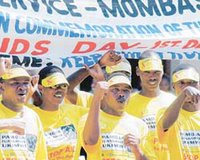
Members of the Administration Police carry a placard along Jomo Kenyatta Avenue during the World Aids day celebrations in Mombasa yesterday.
Photo by Gideon Maunduhttp://www.nationmedia.com/dailynation/nmgindex.aspxxxxxxxxxxxxxxxxxxxxxxxxxxxxx
Kenya's HIV infection rate declines
Story by MUGO NJERU
Publication Date: 2 December 2005New cases of HIV infection among Kenyans have fallen by four per cent in the past two years, fresh statistics show. Figures released during the World Aids Day celebrations yesterday show that the figures have dropped from 10 per cent in 2003 to 6.1 per cent this year. The statistics also show that more than 20 per cent of those infected are now aware of their status, having visited the voluntary counselling and testing centres countrywide.
The decrease in infection rate is attributed to behaviour change, including abstention from casual sex and the use of condoms.
Kenyans were urged not to waver in their behaviour change which could reverse the gains realised in the fight against the scourge.
The celebrations were held at the Kenyatta International Conference Centre and was presided over by Health permanent secretary Zachary Ogongo and the director of the National Aids Control Council, Dr Patrick Orege, among others.
The United Nations Development Programme representative, Mr Andre de la Porte, said the infection rate could be reduced further if the campaigns targeted young women aged between 15 and 24, who were the majority of those infected. "There is little evidence of progress in addressing the deep-rooted gender inequalities which fuel the epidemic," said Mr de la Porte, who spoke on behalf UNaids.
He said increased rape incidents, female genital mutilation and other sexual crimes had made women vulnerable. He asked the Government to use Aids funds efficiently.
http://www.nationmedia.com/dailynation/nmgcontententry.asp?category_id=1&newsid=62598xxxxxxxxxxxxxxxxxxxxxxxxxxxxxxxxxx
Nimechill
NAIROBI, Kenya, July 21, 2005PSI/Kenya's "Nimechill" youth abstinence campaign, the first of its kind in the country, has became so popular that the phrase "chilling" has been incorporated into the language and culture. Reports also show that almost half of youth surveyed had been exposed to the campaign, and those exposed to the campaign's empowering messages were more likely to believe in their own ability to abstain than those who did not see the campaign.
The campaign seeks to delay teen sexual debut by changing social norms and reducing peer pressure, creating stigma regarding irresponsible, early sex among youth and making abstinence a "cool", smart and responsible choice.
A cartoon logo of a yellow hand giving a "V" or a "peace" sign is used to brand the campaign, and the phrase "Nimechill," (Swahili-English slang meaning "I have chilled" or "I am abstaining")
has become a powerful and instantly recognizable slogan. The logo was recognized by 85% of the target group (10- to 15-year-olds) and nearly two-thirds (64%) understood that "Nimechill" refers to abstinence from premarital sex, according to a national media evaluation survey conducted by PSI.
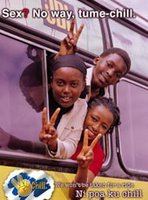
PSI/Kenya's "Nimechill" campaign seeks to delay teen sexual debut by changing social norms and reducing peer pressure

This poster is from a PSI/Kenya campaign encouraging youth to abstain from sex.
http://www.psi.org/xxxxxxxxxxxxxxxxxxxxxxxxxxxxx
VCTVoluntary Counselling and Testing Centres (VCT) have sprung up all over Kenya and have made it much easier for Kenyans to seek advice about HIV and AIDS. Many sports and youth clubs expect members to have passed a HIV test before joining, and to repeat it at regular intervals, e.g. every six months. This, together with the very successful "Nimechill" campaign, is helping to reduce peer pressure to engage in adolescent sex, and is very welcome among community leaders.
The following web sites list VCT centres and explain how they work.
http://www.straightalk.or.ke/vct_centres.htm
http://www.youthaids.org/action/kenya.html
http://www.fhi.org/en/RH/Pubs/Network/v23_3/nt2333.htmIsabelle Prondzynski
***************************** Worldwide useLesotho
AIDS is an every day reality for the people of Lesotho. With adult prevalence rates at 29%, the Kingdom faces one of the greatest burdens of AIDS in sub-Saharan Africa.
In an effort to urgently address the growing epidemic in the country, on World AIDS Day 2005 His Majesty King Letsie III led his nation in a renewed commitment to halting and reversing the spread of AIDS in the country with the launch of a new plan to have every person in the country know their HIV status.
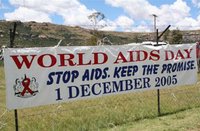
Photo credit: UNAIDS
http://www.unaids.org/xxxxxxxxxxxxxxxxxxxxxxxxxxxxx
United Kingdom
Welcome to World AIDS Day - the international day of action on HIV and AIDS which takes place every year on 1 December.
This year in the UK, World AIDS Day is about wearing the Red Ribbon, as a sign of support for people living with HIV and a symbol of hope for the future. We want you to Wise up and Wear it. If you would like to get hold of your own Red Ribbon you can find your nearest outlet here and you can also download a Virtual Red Ribbon from this site to wear on your website or in your email signature.
World AIDS Day is about people getting the facts about HIV and AIDS. It's a day for people to get involved and there are many ways in which you can do so. We have a listing of events where you can search to find the ones that suit you, or if you are organising an event, you can add details of your event. If you would like to get involved in other ways, we have some great ideas for you!
No matter how you decide to mark the day, you can help create a more AIDS Aware society in which everyone takes action, so please make sure you show off your Red Ribbon on 1 December!
http://www.worldaidsday.org/default.asp*****************************
Things found on the way46664"AIDS is no longer just a disease it is a human rights issue."Nelson Mandela46664 is Nelson Mandela's campaign to help raise Global awareness of AIDS/HIV. 46664 launched last Autumn by Mandela in London aims to highlight the emergency of AIDS/HIV through unique live events and music related initiatives.
46664 was the former President of South Africa's prison number when he was held in captivity for 18 years on Robben Island in Cape Town. Last November a huge Concert was held at Green Point Stadium in Cape Town which featured a galaxy of international music talent including Beyonce, Bono, Dave Stewart, Queen and Anastasia. This show was the first of many planned world wide events.
www.mediazone.com/channel/mandela/jsp/index.jsp
*****************************
HAIKURosemary --
your absence still present
every dayAIDS test
even the good outcome
with trepidation
Isabelle Prondzynski, World AIDS Day 2005
xxxxxxxxxxxxxxxxxxxxxxxxxxxxx
aids report. . .
her tears fall
on her baby in arms
torn between -
sick child, sick husband
aids report and god Aids is a very big threat in India, but an awareness is definately building up amongst the people.
Still we have a long, long way to go.
Kala Ramesh, India
xxxxxxxxxxxxxxxxxxxxxxxxxxxxx
Plump healthy strong man
I looked elsewhere for a while
Now frail and thin, AIDSGalefetolwe Sethapo
http://www.thuto.org/english/courses/eng434/botshaiku.htm
xxxxxxxxxxxxxxxxxxxxxxxxxxxxx
learning how deep
sexless love can be - holding hands
in the spring meadowhttp://www.ahapoetry.com/twchp2.htm
xxxxxxxxxxxxxxxxxxxxxxxxxxxxx
From my toes on up
I'm learning to survive this
HIV and AIDS
http://www.hivstopswithme.org/contributor_article.aspx?t=EN&l=home&c=stevan&id=110.........................................
HIV / AIDS Awareness event in Kayole 17 May 2008 :::::::::::::::::::::::::::::::::::::::::::::::::::::::::::::::::::::::::::::::::::::::::::::::::::::
happy happy bar--
drunkards take HIV test
when drinking beer
HIV rally--
jack declares his positive
status daytime
HIV virus--
she has lived positively
twenty years Barrack Elungata
Kenya, June 2011
*****************************Related words*****
:::::::::::::::::::::::::::::::::::::::::::::::::::::::::::::::::::::::::::::::::::::::::::::::::::::
[ . BACK to WORLDKIGO . TOP . ]:::::::::::::::::::::::::::::::::::::::::::::::::::::::::::::::::::::::::::::::::::::::::::::::::::::


















